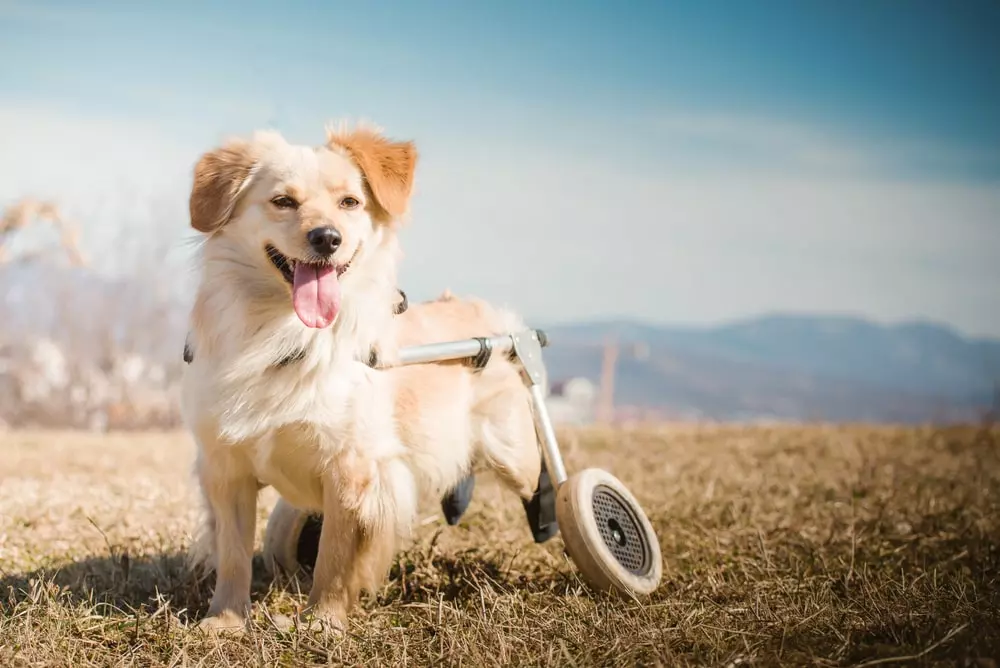PET HEALTH
Intervertebral Disc Disease in Dogs: Symptoms, Treatment & Cost
If your dog has less spring in their step and seems to be dealing with back pain, it may be due to a condition called intervertebral disc disease (IVDD) — commonly referred to as a herniated disc or a slipped disc.
Unfortunately, this is a degenerative disease that can cause a host of problems for your dog and be costly to treat. Let’s walk through what IVDD is, what the risk factors are, and what pet parents’ treatment options may be.
A MetLife Pet Insurance policy can help cover IVDD exam and treatment costs.
We Can Help Reimburse1 Expensive IVDD Surgery Costs
What Is IVDD in Dogs?
IVDD affects the intervertebral discs that help protect the spinal cord. These discs are made of flexible cartilage and sit between the bony vertebrae of the spinal column. Essentially, they allow your dog’s back to bend and twist comfortably and act as shock absorbers when your dog runs, jumps, and plays.2
When a dog develops IVDD, their discs calcify and harden. When this happens, the discs could become displaced, deteriorate, rupture, or protrude. Slipped discs in dogs can cause pain and could lead to paralysis without medical intervention.2
Types of IVDD in Dogs
There are two key types of IVDD, usually referred to as Hansen type I and Hansen type II.3
Hansen type I
Hansen type I tends to affect chondrodystrophic breeds (small dogs with short legs and long backs), including:3
With this type of IVDD, the disc can become damaged more easily and break down over time as it hardens and loses its flexibility. Strenuous activity, such as jumping, could cause the disc to burst, and the “gel” found within the disc can press against the spinal cord.3
Hansen type II
With this type, the discs harden and break down more slowly. Over time, the thick fibers around the soft disc material collapse, resulting in compression against the spinal cord. This type is more common in larger dogs, like:3
IVDD Symptoms in Dogs
Symptoms of IVDD can vary depending on where the disc in the spine is herniated. The spine has five regions: the cervical, thoracic, lumbar, sacral, and caudal vertebrae.4
Signs of IVDD in dogs can include:3,4
- Back or neck pain
- An arched back or neck
- Difficulty moving
- Loss of bladder or bowel control
- Lameness or limping
- Weakness
- Reluctance to climb stairs, jump, or walk
- Lack of coordination
- Paralysis
Knowing the signs and symptoms of IVDD may help you determine if your dog is developing the condition. Severe IVDD can impact a dog’s quality of life. However, there are options available to treat the disease and slow its progression, especially if you can catch it in the early stages.
While treatment options exist, the costs can add up — especially if your dog has a more severe case of IVDD. Fortunately, a dog insurance policy with MetLife Pet can typically help cover medications, surgery, and diagnostic imaging. Get a fast, free quote.
Treatment for IVDD in Dogs: What To Expect
It’s recommended that IVDD be treated as early as possible to avoid permanent damage and paralysis.2,3 Luckily, many vets are prepared and ready to help pets with IVDD. Here’s what usually occurs to diagnose IVDD in dogs and the typical treatment plan.
Diagnosing IVDD in dogs
Your vet may take an X-ray to rule out other diseases that can affect your dog’s ability to walk, such as bone cancer or hip dysplasia.2 If those results come back without indications of other diseases, your vet will take steps to figure out what type of IVDD your dog may have and where the spinal cord is injured.
One test they may choose to use is a type of sonogram called a myelogram to identify the affected areas of the spinal cord.4 A myelogram involves placing a dye onto the spine, which surrounds the spinal cord to highlight the affected discs.5
In addition, the vet may order an MRI or CT scan for a better understanding of which areas of the spine are affected.4
Treatment options for IVDD in dogs
Treatment for IVDD will depend on the severity of the disorder. If the damage to their spine isn’t severe, your vet may prescribe steroids and anti-inflammatory medications.4 The goal of these medications is to reduce swelling and pain.
Your vet will likely advise strict crate rest to manage the disorder along with these medications to make sure your pet’s spine can heal.2,4
Sadly, not every dog is a good candidate for this treatment. Some dogs may need surgery to replace their discs and relieve the compression of their spine. The majority of dogs who undergo this surgery can fully recover with minimal complications.3
However, dogs with very severe cases of IVDD are at risk of becoming paralyzed during the procedure.4 It’s recommended to discuss the pros and cons of surgery with your vet before pursuing this route.
Lifestyle changes for dogs with IVDD
Some cases of IVDD can be managed with lifestyle adjustments and physical therapy.3 Pet parents may be advised to have their dogs do certain exercises to help them relax and maintain a certain quality of life.
Your dog’s lifestyle may need to be adjusted to prevent further damage to their body. Expect to replace doggy dates at the park with light walks and shorter play sessions for roughly 4 – 6 weeks.4 Ramps and steps to get on and off furniture can also help prevent your pet from straining and hurting themselves.
How Much Does IVDD Surgery Cost?
The cost of treating IVDD depends on what sort of treatment your dog is getting. Like all veterinary care, the cost of care depends on where you live and the type of veterinary specialist.
The cost of IVDD surgery can cost anywhere between $1,500 and $4,000.3 This cost range doesn’t include the cost of an X-ray, MRI, CT scan, or medications your vet may prescribe. Your vet may also charge you for bandages to cover your pet’s stitches, similar to bandages used for an injured paw. Comprehensive expenses may fall more in the range of $3,000 – $8,000.3
Alternative methods of treatment — like physical therapy, hydrotherapy, and laser therapy — might also be recommended to help your dog regain their mobility and heal faster, but at an additional cost.
It should be noted that while IVDD can be treated, it can’t be cured. Pet parents could find themselves spending thousands of dollars as the disease progresses over time.
Pet Insurance Could Help Offset Expenses Treating IVDD in Dogs
Managing a progressive disease like IVDD can be very stressful, but treatment is available to help your dog maintain a quality life. That’s why it could be helpful to have a dog insurance policy in your back pocket, especially if you own a breed of dog that’s prone to this disease.
A MetLife Pet policy may help offset the cost of treating IVDD so you can focus more on your furry friend rather than your wallet. Get a free quote, and learn more about how pet insurance works to see how MetLife Pet Insurance can help you take care of your beloved pet.
Coverage for IVDD in Dogs
Get Help With the Cost of Surgery
Penny, a 5-year-old mixed-breed pup from Kentucky, had a severe case of IVDD that required surgery to help improve her quality of life.
Penny's claim $5,700
MetLife Pet covered5
$4,600
Save on the Cost of Exams
When Rose, a 9-year-old dog from Tennessee, was having trouble climbing the stairs and going on walks, her parents took her to the vet for testing.
Rose's claim $1,000
MetLife Pet covered6
$900
Get Reimbursed for Therapeutic Treatments
After being diagnosed with IVDD, Leo, a 4-year-old mixed-breed dog from California, was advised to start hydrotherapy to help treat his condition.
Leo's claim $300
MetLife Pet covered7
$270



